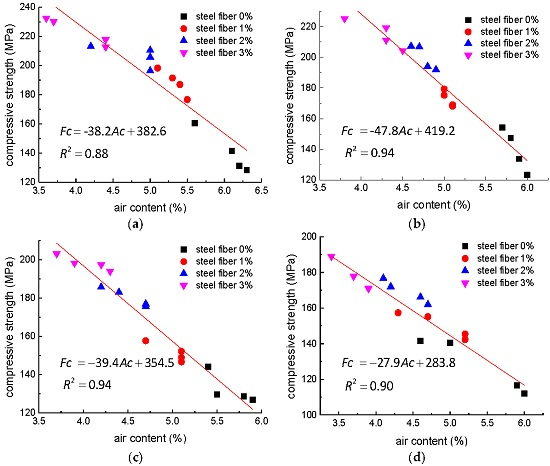Relationship between Flowability, Entrapped Air Content and Strength of UHPC Mixtures Containing Different Dosage of Steel Fiber
Abstract
:1. Introduction
2. Experimental Section
2.1. Raw Materials
2.2. Mixing Proportions of UHPC Mixtures
2.3. Mixing Procedure and Specimen Preparation
2.4. Flowability and Air Content Test
2.5. Strength Measurement
3. Results and Discussion
3.1. The Flowability of Fresh Mixture
3.2. The Entrapped Air in Fresh Mixture
3.3. The Relationship between Flowability and Entrapped Air Content
3.4. Compressive and Flexural Strength
3.4.1. Compressive Strength
3.4.2. Flexural Strength
3.5. The Relationship between Compressive Strength and Entrapped Air Content
4. Conclusions
Acknowledgments
Author Contributions
Conflicts of Interest
References
- Richard, P.; Cheyrezy, M. Composition of reactive powder concretes. Cem. Concr. Res. 1995, 25, 1501–1511. [Google Scholar] [CrossRef]
- Habel, K.; Viviani, M.; Denarie, E.; Bruhwiler, E. Development of the mechanical properties of an Ultra-High Performance Fiber Reinforced Concrete (UHPFRC). Cem. Concr. Res. 2006, 36, 1362–1370. [Google Scholar] [CrossRef]
- Wang, D.; Shi, C.J.; Wu, Z.; Xiao, J.; Huang, Z.; Fang, Z. A review on ultra high performance concrete: Part II. Hydration, microstructure and properties. Constr. Build. Mater. 2015, 96, 368–377. [Google Scholar] [CrossRef]
- Alkaysi, M.; El-Tawil, S.; Liu, Z.; Hansen, W. Effects of silica powder and cement type on durability of ultra high performance concrete (UHPC). Cem. Concr. Comp. 2016, 66, 47–56. [Google Scholar] [CrossRef]
- Shi, C.J.; Wu, Z.; Xiao, J.; Wang, D.; Huang, Z.; Fang, Z. A review on ultra high performance concrete: Part I. Raw materials and mixture design. Constr. Build. Mater. 2015, 101, 741–751. [Google Scholar] [CrossRef]
- Shi, C.J.; Wang, D.H.; Wu, L.M.; Wu, Z.M. The hydration and microstructure of ultra high-strength concrete with cement–silica fume–slag binder. Cem. Concr. Compos. 2015, 61, 44–52. [Google Scholar] [CrossRef]
- Yu, R.; Spiesz, P.; Brouwers, H.J.H. Development of an eco-friendly Ultra-High Performance Concrete (UHPC) with efficient cement and mineral admixtures uses. Cem. Concr. Compos. 2015, 55, 383–394. [Google Scholar] [CrossRef]
- Tafraoui, A.; Escadeillas, G.; Lebaili, S.; Vidal, T. Metakaolin in the formulation of UHPC. Constr. Build. Mater. 2009, 23, 669–674. [Google Scholar] [CrossRef]
- Van Tuan, N.; Ye, G.; Van Breugel, K.; Copuroglu, O. Hydration and microstructure of ultra high performance concrete incorporating rice husk ash. Cem. Concr. Res. 2011, 41, 1104–1111. [Google Scholar] [CrossRef]
- Park, J.S.; Kim, Y.J.; Cho, J.R.; Jeon, S.J. Early-Age Strength of Ultra-High Performance Concrete in Various Curing Conditions. Materials 2015, 8, 5537–5553. [Google Scholar] [CrossRef]
- Wille, K.; Naaman, A.; El-Tawil, S.; Parra-Montesinos, G. Ultra-high performance concrete and fiber reinforced concrete: Achieving strength and ductility without heat curing. Mater. Struct. 2012, 45, 309–324. [Google Scholar] [CrossRef]
- Kang, S.-T.; Lee, Y.; Park, Y.-D.; Kim, J.-K. Tensile fracture properties of an Ultra High Performance Fiber Reinforced Concrete (UHPFRC) with steel fiber. Compos. Struct. 2010, 92, 61–71. [Google Scholar] [CrossRef]
- Abbas, S.; Soliman, A.M.; Nehdi, M.L. Exploring mechanical and durability properties of ultra-high performance concrete incorporating various steel fiber lengths and dosages. Constr. Build. Mater. 2015, 75, 429–441. [Google Scholar] [CrossRef]
- Wu, Z.M.; Shi, C.J.; He, W.; Wu, L.M. Effects of steel fiber content and shape on mechanical properties of ultra high performance concrete. Constr. Build. Mater. 2016, 103, 8–14. [Google Scholar] [CrossRef]
- Kang, S.T.; Lee, B.Y.; Kim, J.K.; Kim, Y.Y. The effect of fibre distribution characteristics on the flexural strength of steel fibre-reinforced ultra high strength concrete. Construct. Build. Mater. 2011, 25, 2450–2457. [Google Scholar] [CrossRef]
- Yu, R.; Spiesz, P.; Brouwers, H.J.H. Mix design and properties assessment of ultra-high performance fibre reinforced concrete (UHPFRC). Cem. Concr. Res. 2014, 56, 29–39. [Google Scholar] [CrossRef]
- Chinese National Standard. Common Portland Cement; Chinese National Standard: Beijing, China, 2007; GB175-2007. [Google Scholar]
- Chinese National Standard. Silica Fume from Electric-furnace; Chinese National Standard: Beijing, China, 2007; GB/T 21236-2007. [Google Scholar]
- Chinese National Standard. Test Method for Fluidity of Cement Mortar; Chinese National Standard: Beijing, China, 2005; GB/T 2419–2005. [Google Scholar]
- British Standard. Testing Fresh Concrete; British Standard: London, UK, 2009; EN 12350–7:2009. [Google Scholar]
- Chinese National Standard. Method of Testing Cements-Determination of Strength; Chinese National Standard: Beijing, China, 1999; GB/T 17671-1999. [Google Scholar]
- Yamada, K.; Takahashi, T.; Hanehara, S.; Matsuhisa, M. Effects of the chemical structure on the properties of polycarboxylate-type superplasticizer. Cem. Concr. Res. 2000, 30, 197–207. [Google Scholar] [CrossRef]
- Dils, J.; Boel, V.; Schutter, G.D. Vacuum mixing technology to improve the mechanical properties of ultra-high performance concrete. Mater. Struct. 2015, 48, 3485–3501. [Google Scholar] [CrossRef] [Green Version]
- Balaguru, P.; Ramakrishnan, V. Properties of Fiber Reinforced Concrete: Workability, Behavior under Long-Term Loading, and Air-Void Characteristics. ACI Mater. J. 1988, 85, 189–196. [Google Scholar]
- Uygunoğlu, T. Effect of fiber type and content on bleeding of steel fiber reinforced concrete. Constr. Build. Mater. 2011, 25, 766–772. [Google Scholar] [CrossRef]
- Kostrzanowska-Siedlarz, A.; Gołaszewski, J. Rheological properties and the air content in fresh concrete for self compacting high performance concrete. Constr. Build. Mater. 2015, 94, 555–564. [Google Scholar] [CrossRef]
- Mehta, P.K.; Monteiro, P.J.M. Concrete: Microstructure, Properties, and Materials, 3rd ed.; McGraw-Hill: New York, NY, USA, 2006. [Google Scholar]
- Choi, P.; Yeon, J.H.; Yun, K.K. Air-void structure, strength, and permeability of wet-mix shotcrete before and after shotcreting operation: The influences of silica fume and air-entraining agent. Cem. Concr. Comp. 2016, 70, 69–77. [Google Scholar] [CrossRef]
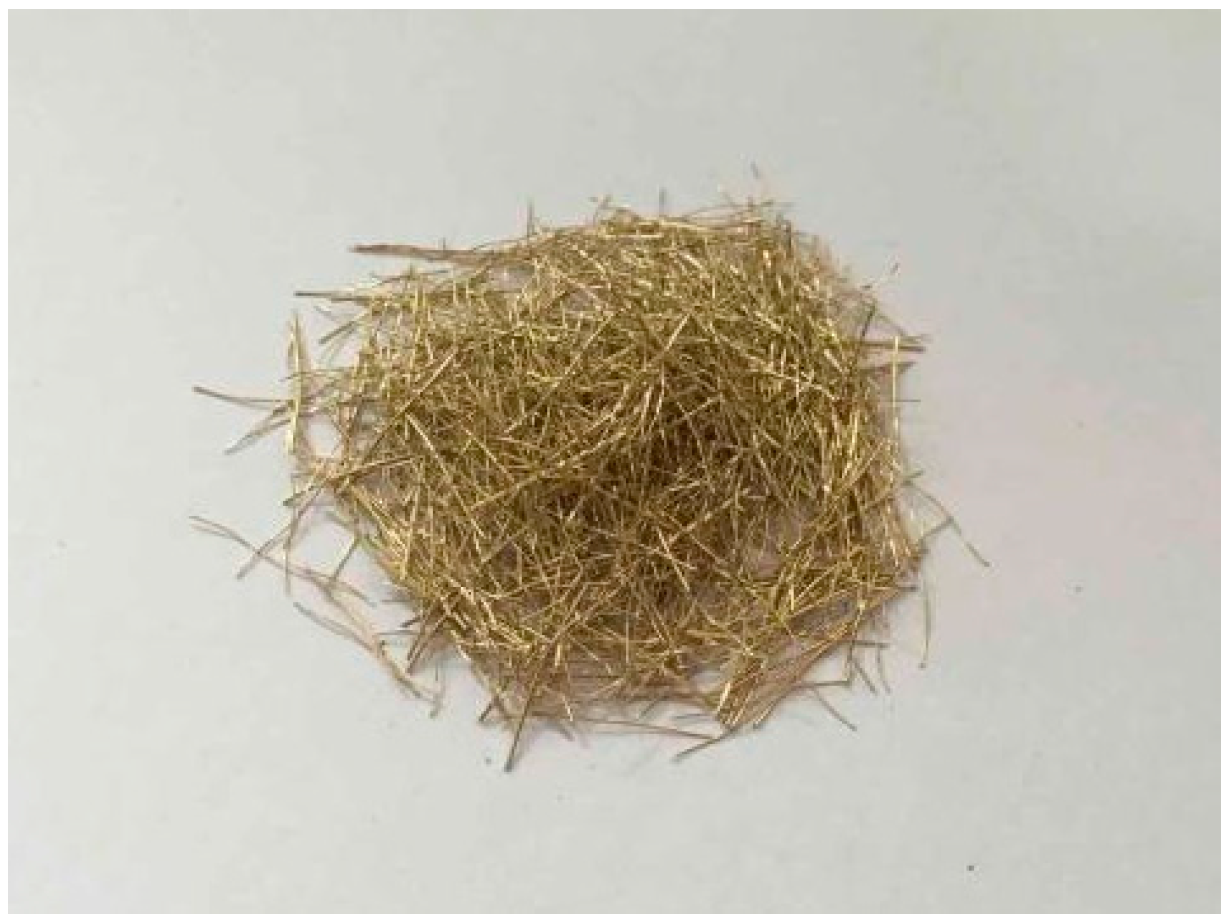
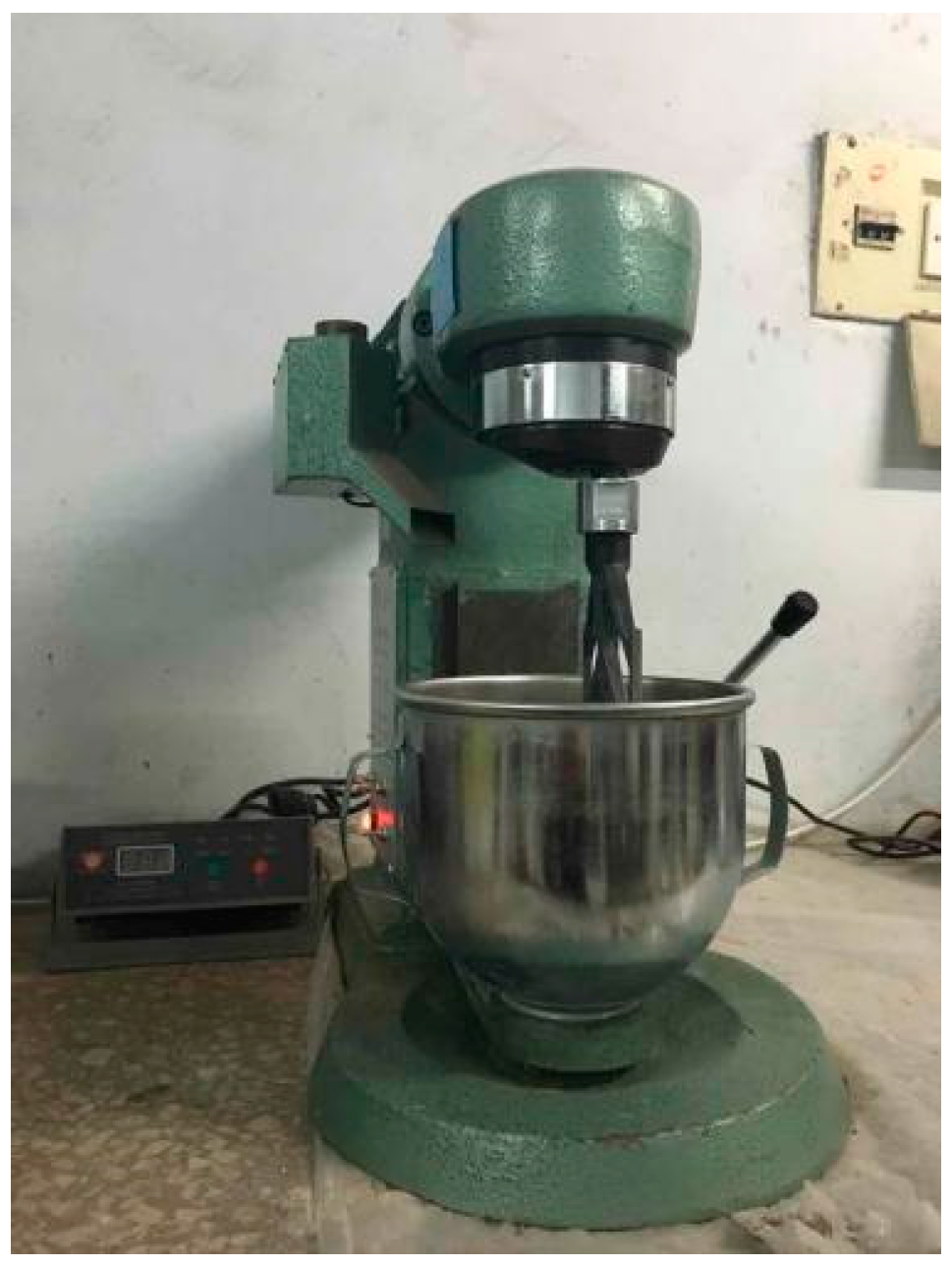
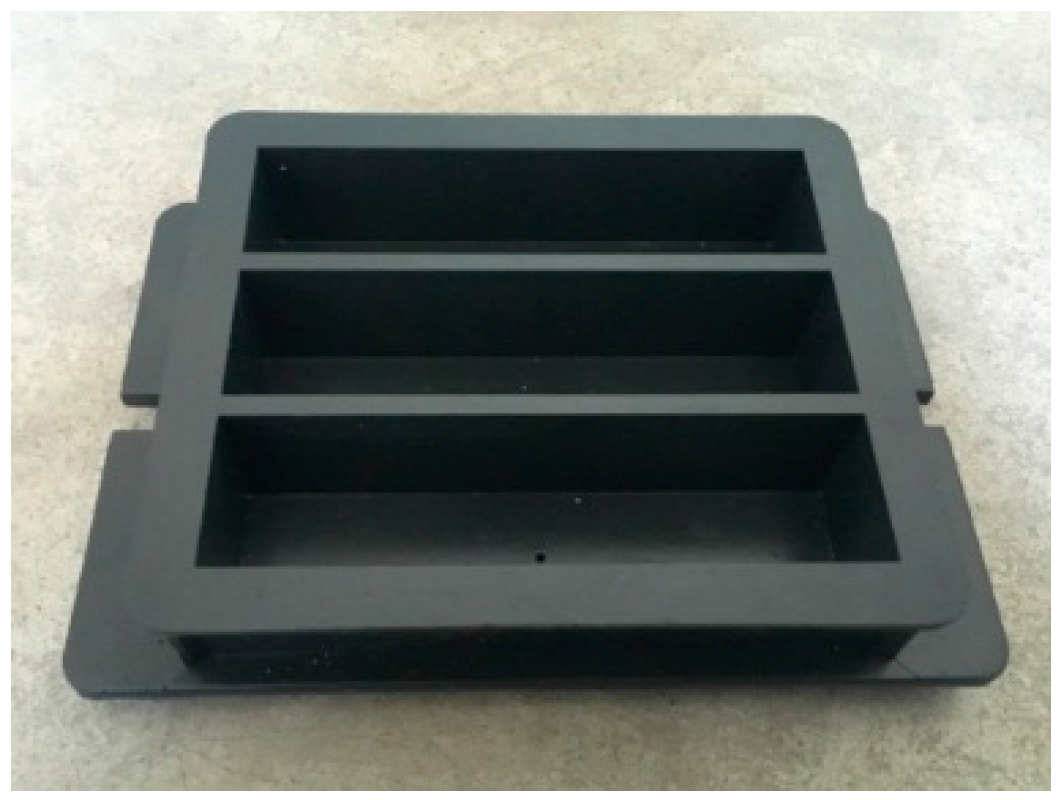
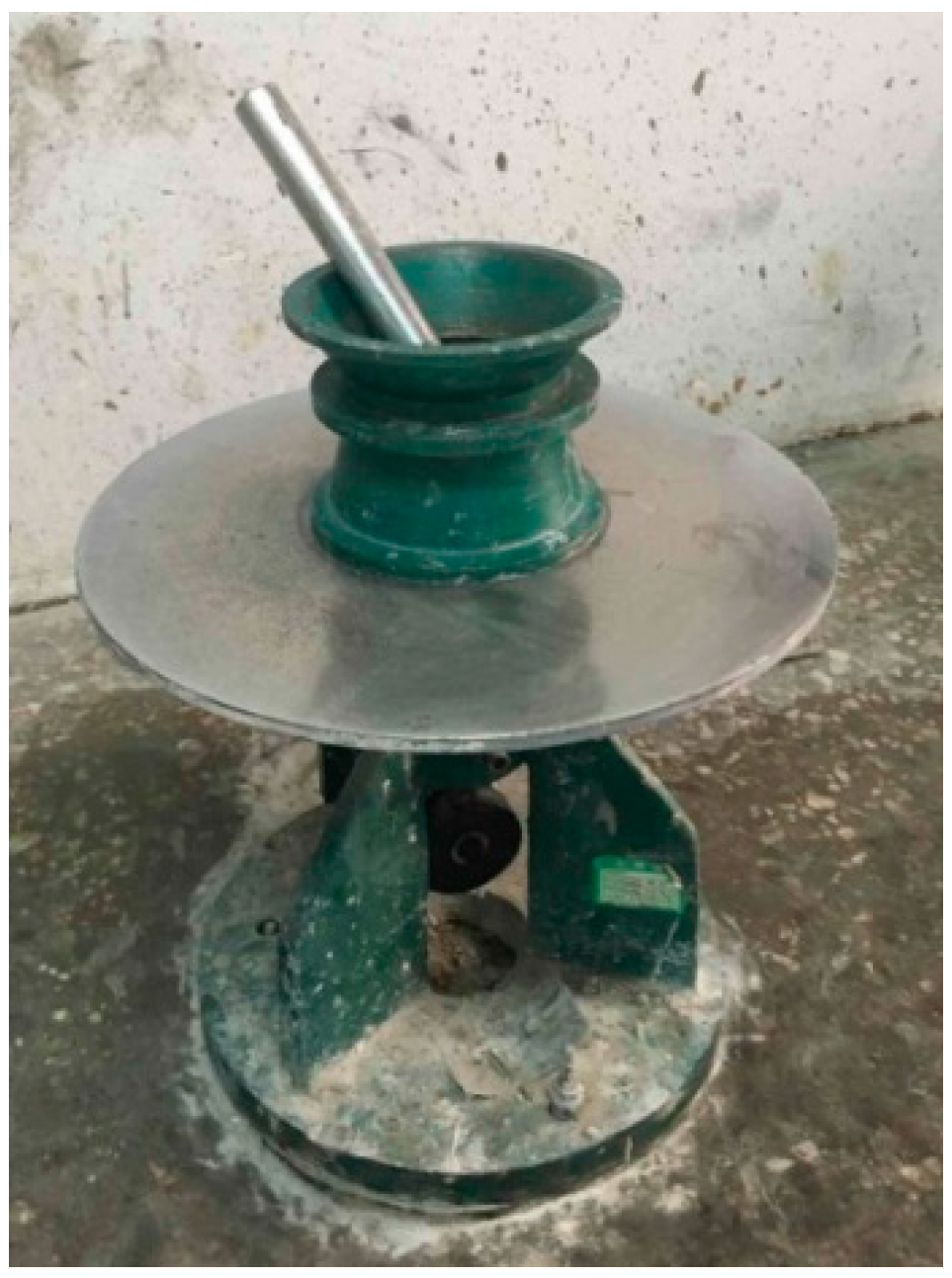
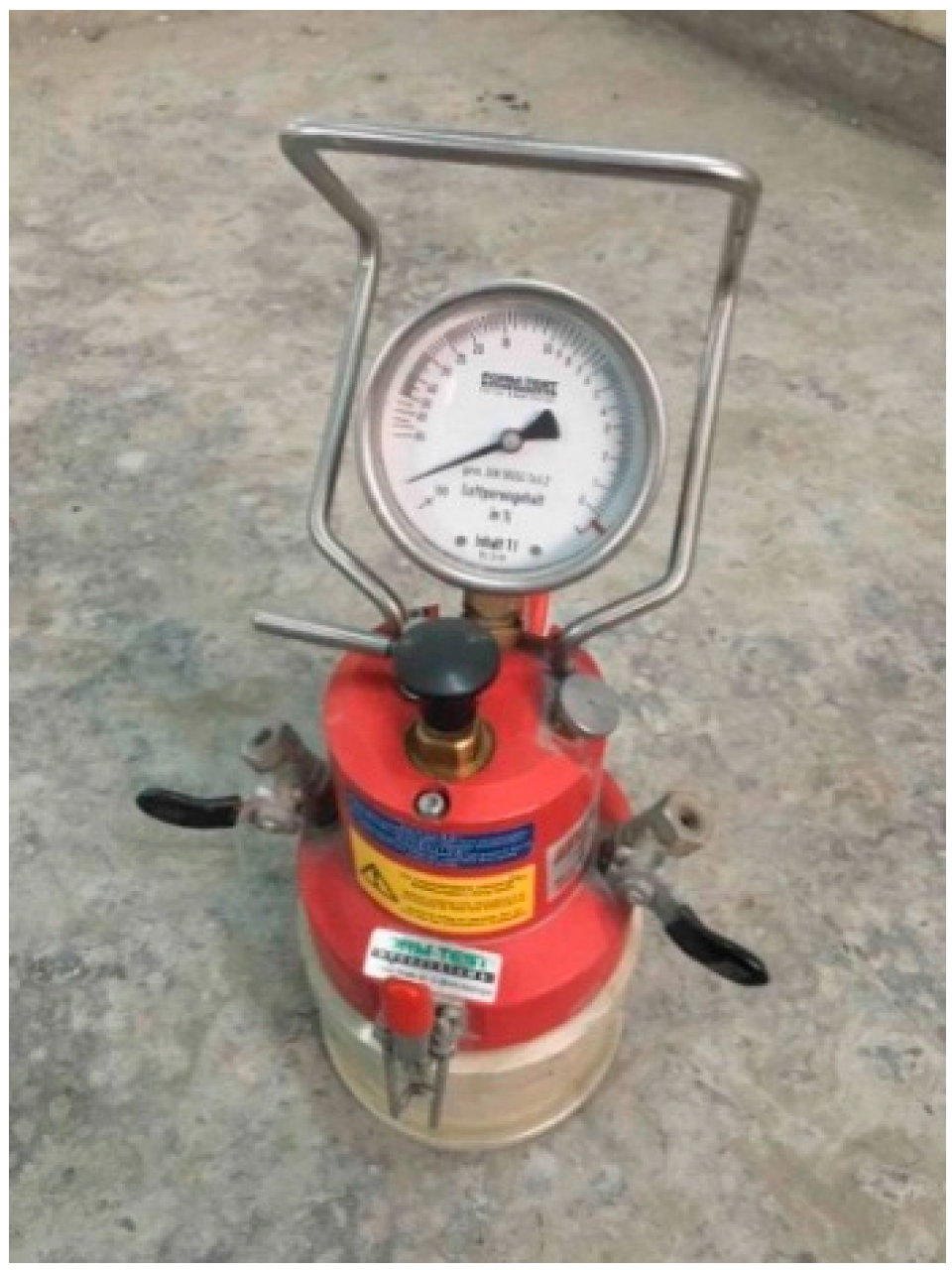
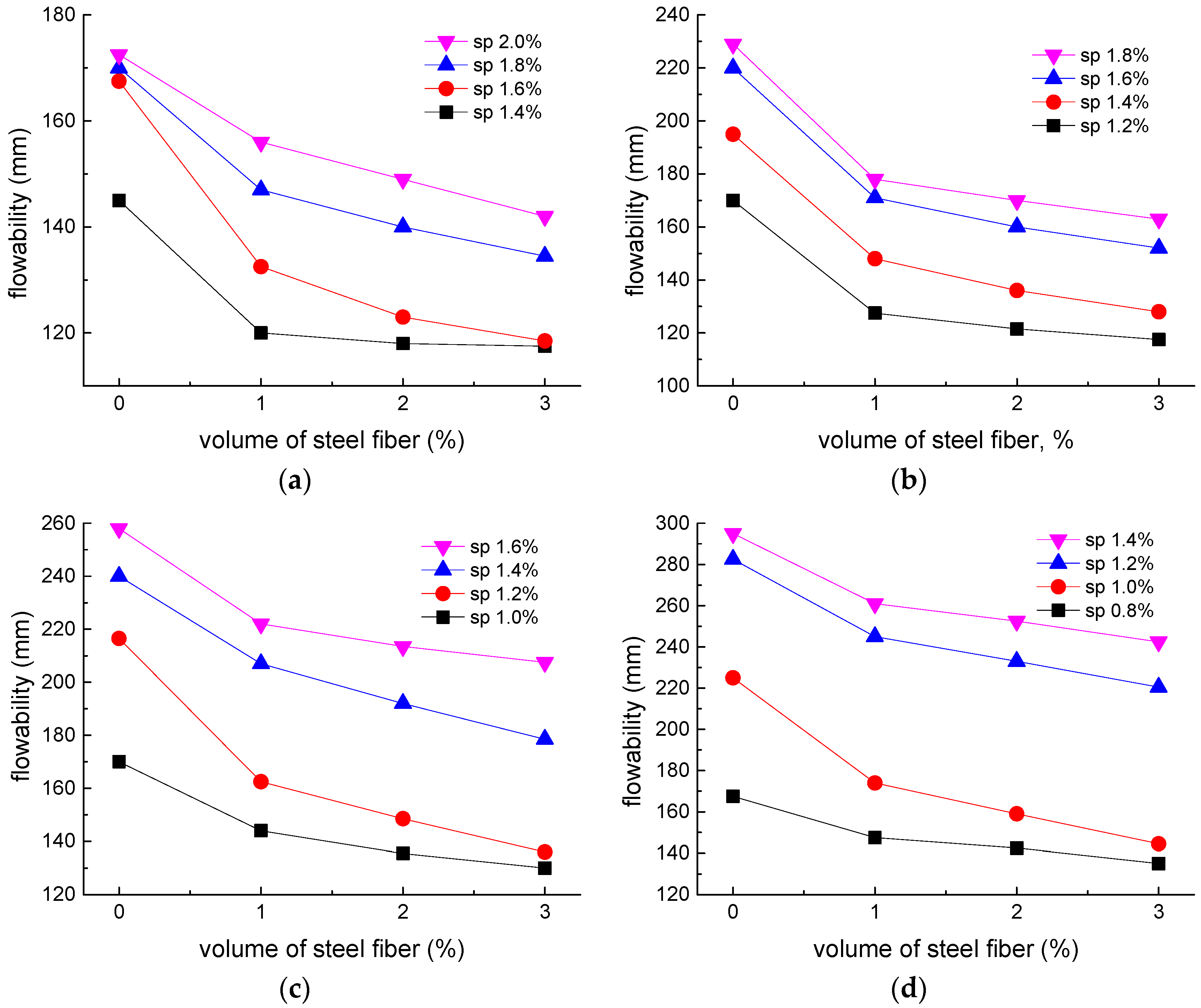
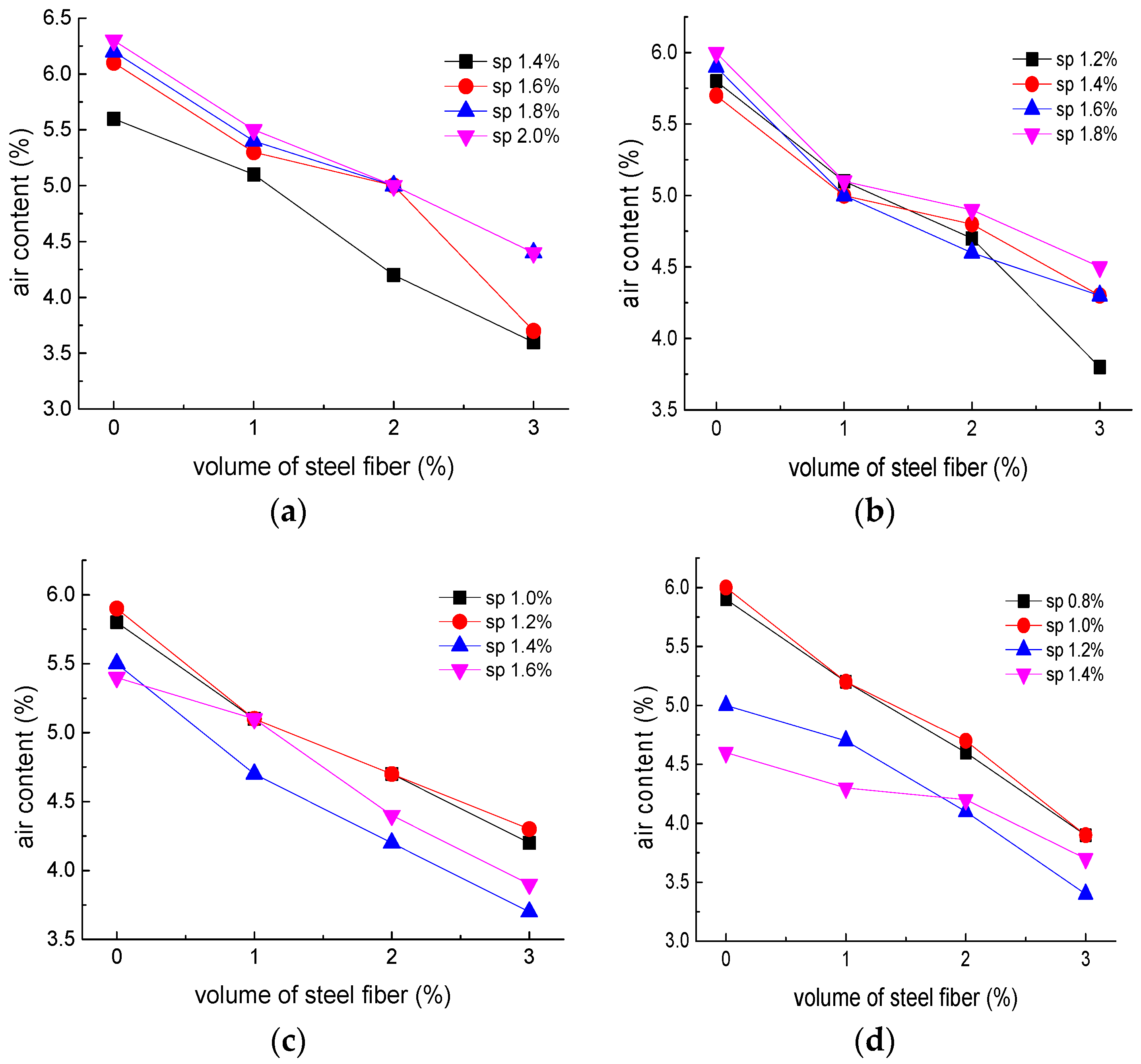
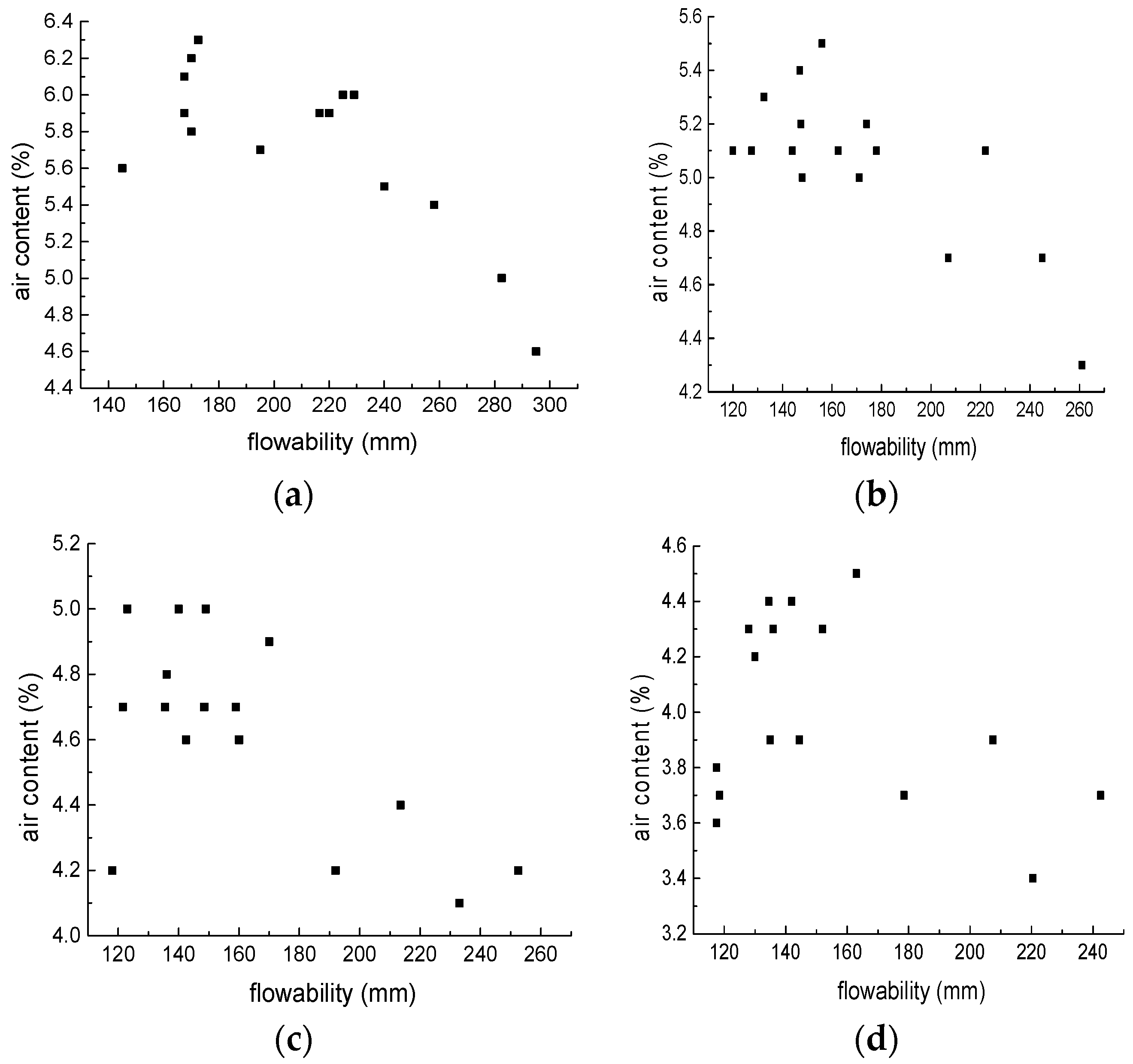
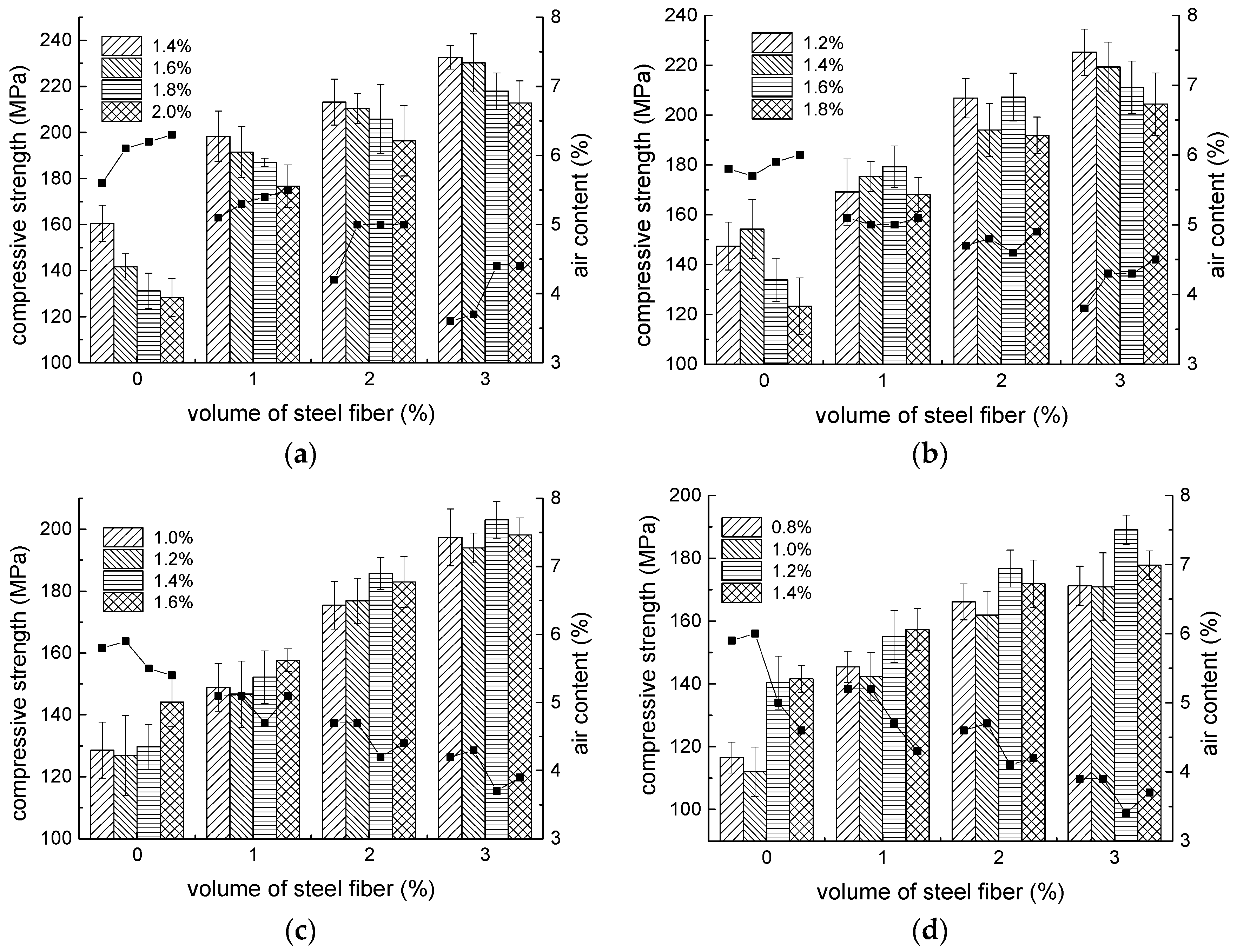
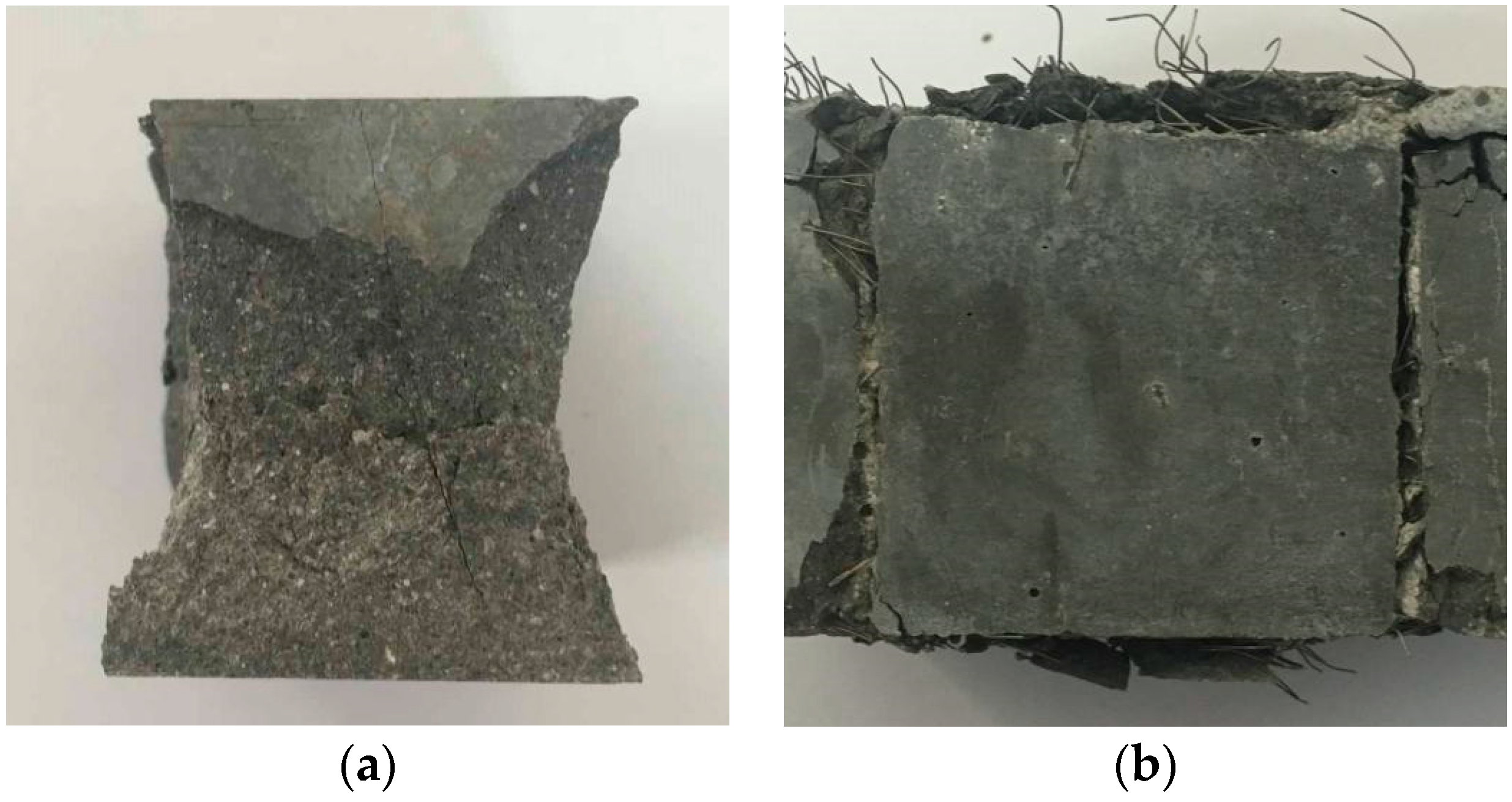
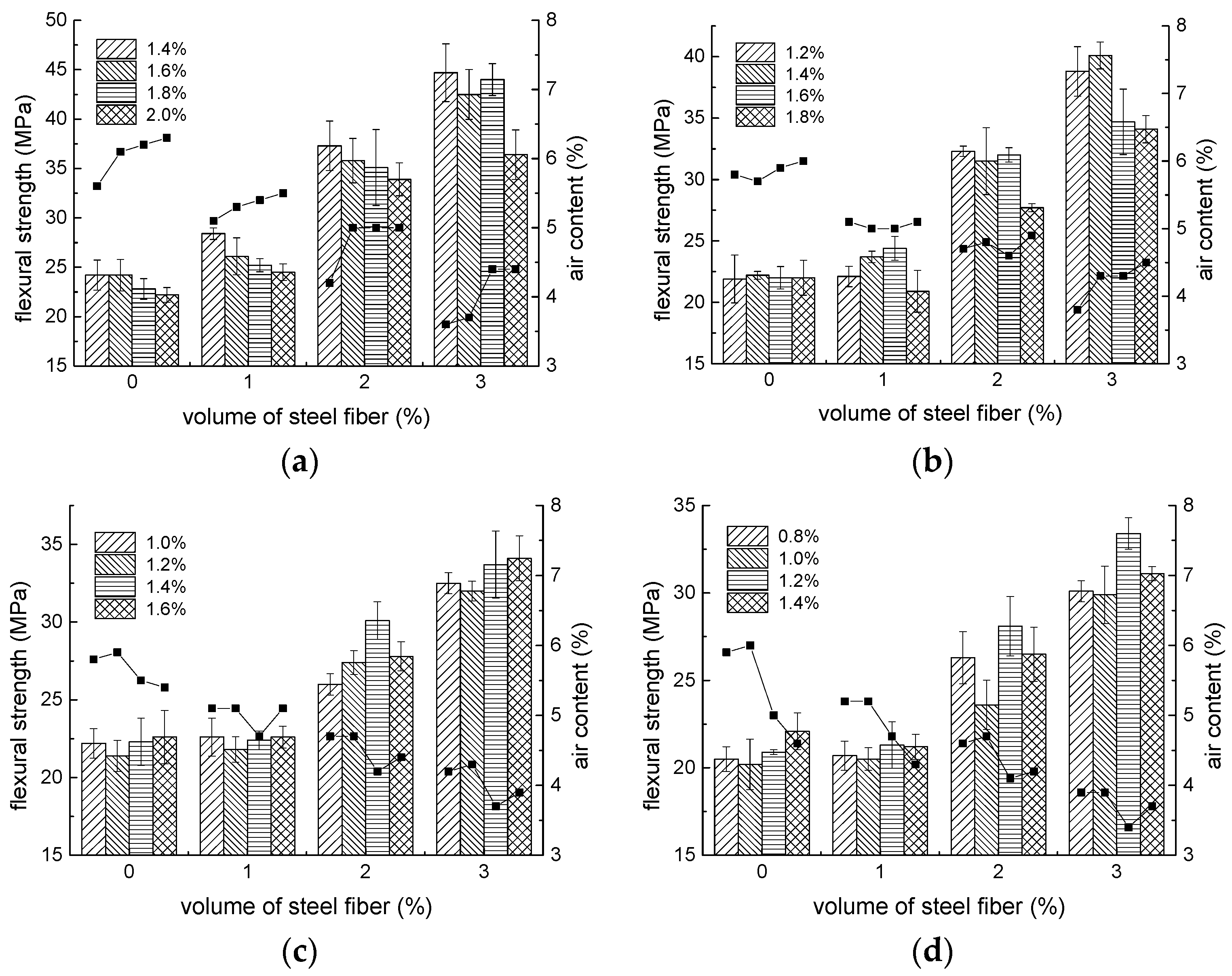
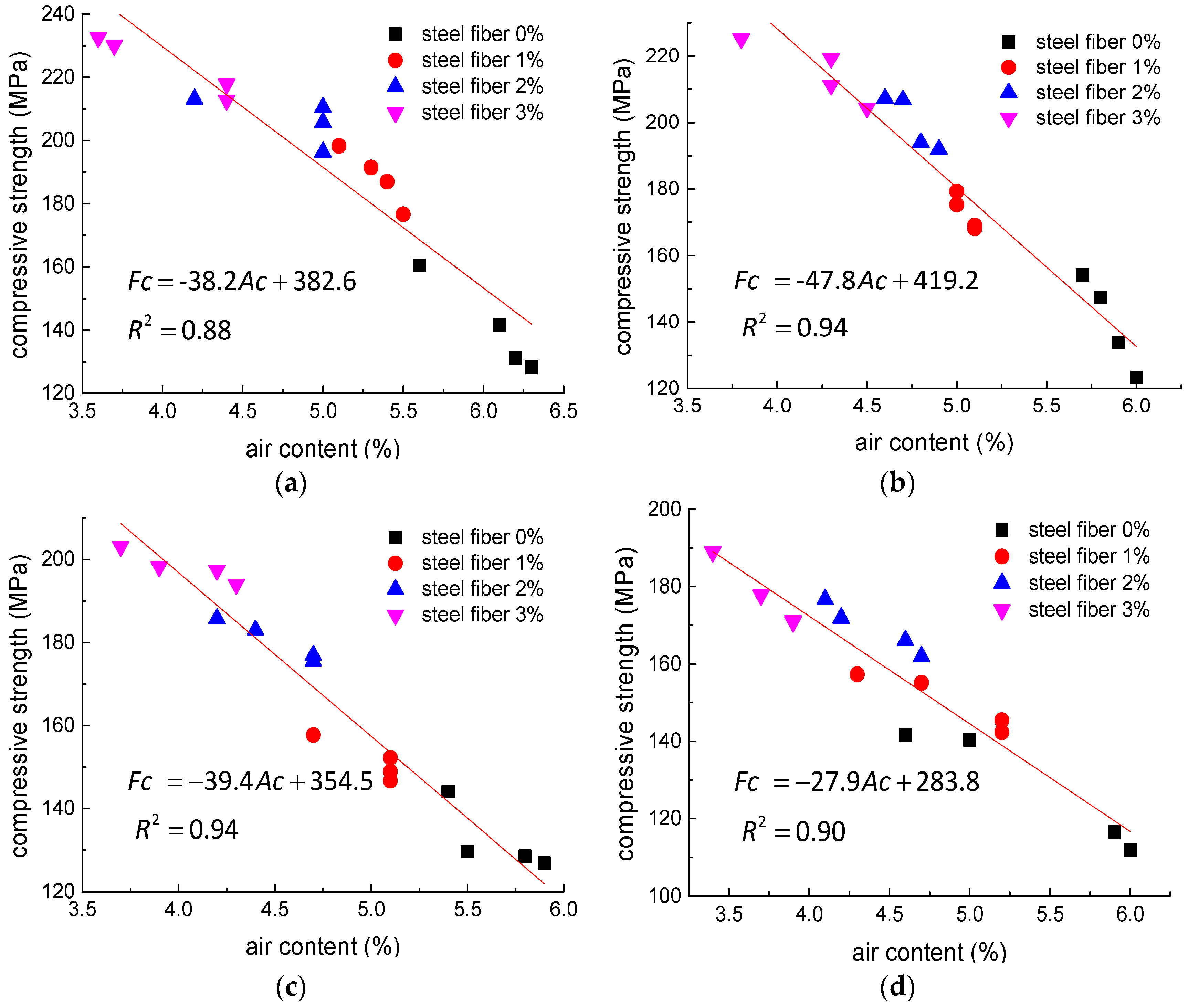
| Constituent | Cement (wt. %) | Silica Fume (wt. %) |
|---|---|---|
| CaO | 64.48 | 1.5 |
| SiO2 | 21.41 | 96.3 |
| Al2O3 | 5.43 | 0.54 |
| Fe2O3 | 3.51 | 0.64 |
| MgO | 1.47 | 0.16 |
| Loss on ignition | 2.54 | 1.43 |
| Quartz Sand Type | Particle Size (μm) | Constituent (wt. %) | Apparent Density (g/cm3) | Bulk Density (g/cm3) | |
|---|---|---|---|---|---|
| SiO2 | Fe2O3 | ||||
| Coarse | 360–600 | ≥99.6 | ≤0.02 | 2.65 | 1.405 |
| Fine | 180–360 | ≥99.6 | ≤0.02 | 2.65 | 1.329 |
| w/b | Cement | Silica Fume | Fine Quartz Sand | Coarse Quartz Sand | SP, by Mass of Binder, % | Steel Fiber, by Volume of Mixture, % |
|---|---|---|---|---|---|---|
| 0.18 | 1 | 0.3 | 0.22 | 0.88 | 1.4 | 0, 1, 2, 3 |
| 1 | 0.3 | 0.22 | 0.88 | 1.6 | ||
| 1 | 0.3 | 0.22 | 0.88 | 1.8 | ||
| 1 | 0.3 | 0.22 | 0.88 | 2 | ||
| 0.2 | 1 | 0.3 | 0.22 | 0.88 | 1.2 | 0, 1, 2, 3 |
| 1 | 0.3 | 0.22 | 0.88 | 1.4 | ||
| 1 | 0.3 | 0.22 | 0.88 | 1.6 | ||
| 1 | 0.3 | 0.22 | 0.88 | 1.8 | ||
| 0.22 | 1 | 0.3 | 0.22 | 0.88 | 1 | 0, 1, 2, 3 |
| 1 | 0.3 | 0.22 | 0.88 | 1.2 | ||
| 1 | 0.3 | 0.22 | 0.88 | 1.4 | ||
| 1 | 0.3 | 0.22 | 0.88 | 1.6 | ||
| 0.24 | 1 | 0.3 | 0.22 | 0.88 | 0.8 | 0, 1, 2, 3 |
| 1 | 0.3 | 0.22 | 0.88 | 1 | ||
| 1 | 0.3 | 0.22 | 0.88 | 1.2 | ||
| 1 | 0.3 | 0.22 | 0.88 | 1.4 |
© 2016 by the authors; licensee MDPI, Basel, Switzerland. This article is an open access article distributed under the terms and conditions of the Creative Commons Attribution (CC-BY) license (http://creativecommons.org/licenses/by/4.0/).
Share and Cite
Wang, R.; Gao, X. Relationship between Flowability, Entrapped Air Content and Strength of UHPC Mixtures Containing Different Dosage of Steel Fiber. Appl. Sci. 2016, 6, 216. https://doi.org/10.3390/app6080216
Wang R, Gao X. Relationship between Flowability, Entrapped Air Content and Strength of UHPC Mixtures Containing Different Dosage of Steel Fiber. Applied Sciences. 2016; 6(8):216. https://doi.org/10.3390/app6080216
Chicago/Turabian StyleWang, Rui, and Xiaojian Gao. 2016. "Relationship between Flowability, Entrapped Air Content and Strength of UHPC Mixtures Containing Different Dosage of Steel Fiber" Applied Sciences 6, no. 8: 216. https://doi.org/10.3390/app6080216





